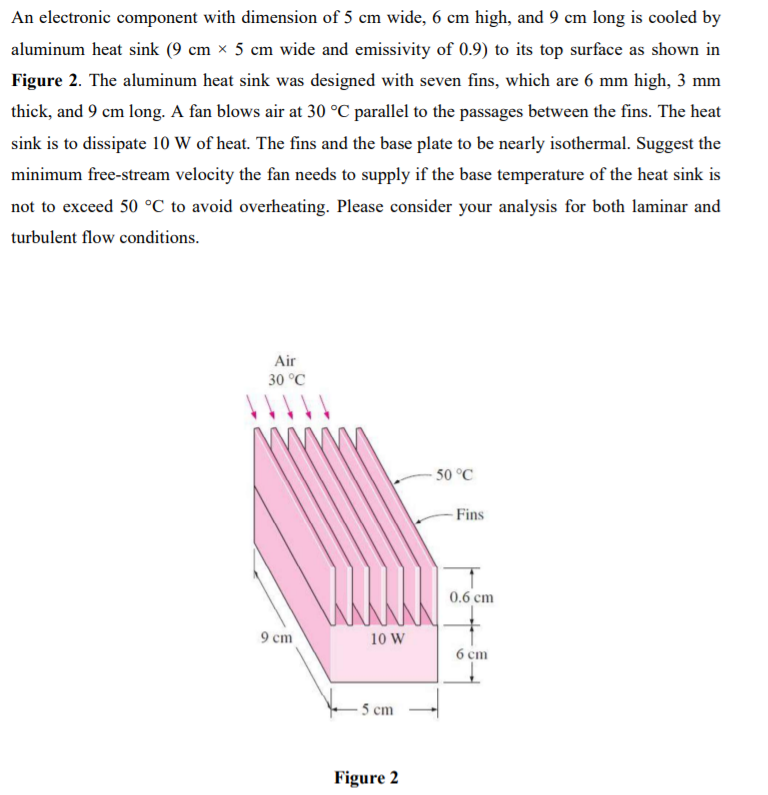An electronic component with dimension of 5 cm wide, 6 cm high, and 9 cm long is cooled by aluminum heat sink (9 cm × 5 cm wide and emissivity of 0.9) to its top surface as shown in Figure 2. The aluminum heat sink was designed with seven fins, which are 6 mm high, 3 mm thick, and 9 cm long. A fan blows air at 30 °C parallel to the passages between the fins. The heat sink is to dissipate 10 W of heat. The fins and the base plate to be nearly isothermal. Suggest the minimum free-stream velocity the fan needs to supply if the base temperature of the heat sink is not to exceed 50 °C to avoid overheating. Please consider your analysis for both laminar and turbulent flow conditions.
An electronic component with dimension of 5 cm wide, 6 cm high, and 9 cm long is cooled by aluminum heat sink (9 cm × 5 cm wide and emissivity of 0.9) to its top surface as shown in Figure 2. The aluminum heat sink was designed with seven fins, which are 6 mm high, 3 mm thick, and 9 cm long. A fan blows air at 30 °C parallel to the passages between the fins. The heat sink is to dissipate 10 W of heat. The fins and the base plate to be nearly isothermal. Suggest the minimum free-stream velocity the fan needs to supply if the base temperature of the heat sink is not to exceed 50 °C to avoid overheating. Please consider your analysis for both laminar and turbulent flow conditions.
Principles of Heat Transfer (Activate Learning with these NEW titles from Engineering!)
8th Edition
ISBN:9781305387102
Author:Kreith, Frank; Manglik, Raj M.
Publisher:Kreith, Frank; Manglik, Raj M.
Chapter6: Forced Convection Over Exterior Surfaces
Section: Chapter Questions
Problem 6.36P
Related questions
Question

Transcribed Image Text:An electronic component with dimension of 5 cm wide, 6 cm high, and 9 cm long is cooled by
aluminum heat sink (9 cm × 5 cm wide and emissivity of 0.9) to its top surface as shown in
Figure 2. The aluminum heat sink was designed with seven fins, which are 6 mm high, 3 mm
thick, and 9 cm long. A fan blows air at 30 °C parallel to the passages between the fins. The heat
sink is to dissipate 10 W of heat. The fins and the base plate to be nearly isothermal. Suggest the
minimum free-stream velocity the fan needs to supply if the base temperature of the heat sink is
not to exceed 50 °C to avoid overheating. Please consider your analysis for both laminar and
turbulent flow conditions.
Air
30 °C
50 °C
Fins
0.6 cm
9 cm
10 W
6 cm
- 5 cm
Figure 2
Expert Solution
This question has been solved!
Explore an expertly crafted, step-by-step solution for a thorough understanding of key concepts.
Step by step
Solved in 2 steps

Knowledge Booster
Learn more about
Need a deep-dive on the concept behind this application? Look no further. Learn more about this topic, mechanical-engineering and related others by exploring similar questions and additional content below.Recommended textbooks for you

Principles of Heat Transfer (Activate Learning wi…
Mechanical Engineering
ISBN:
9781305387102
Author:
Kreith, Frank; Manglik, Raj M.
Publisher:
Cengage Learning

Principles of Heat Transfer (Activate Learning wi…
Mechanical Engineering
ISBN:
9781305387102
Author:
Kreith, Frank; Manglik, Raj M.
Publisher:
Cengage Learning